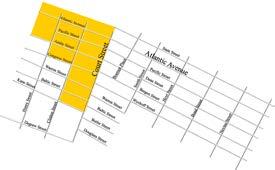SPRING 2016
Significance Assessment The Cobble Hill and Boerum Hill historic districts were designated in 1968 and 1973, respectively, which today gives us close to a 50 year period to investigate changes and impacts upon the area. As per the original designation reports, the neighborhoods are characterized by their low-scale, uniform rooflines, overall visual harmony, historic ironwork and their abundance of mid-19th century row houses that remain relatively unchanged. The residential architecture is predominantly Greek Revival or Italianate row houses with stoops, with brick being the most abundant façade material. The buildings average about 3 to 5 stories in height and are examples of the early development of the area in the 1830s to 1850s. Reading through the original designations, it is clear that the area was considered significant primarily for these residential architectural features. However, throughout our investigation, we have uncovered other features of equal importance, and feel that the significance of the area can only be truly understood if these are taken into account as well. While the row houses of the area are a main constituent of the building stock, the area was also an important testing ground for the development of the first reform tenement housing by Alfred T. White at Warren Place. Increasingly during the mid-20th century, in response to new waves of immigration, economic depressions, and changes in infrastructure, single-family rowhouses were broken up into apartments, stores and industry moved or changed, and new housing projects were constructed (such as the Gowanus and Wyckoff Houses to the south of the area). The study area – both in and out of historic districts – still contains many examples of tenements, apartments, and housing projects, which are today an integral part of the history of the area. Also unmentioned in the original designation reports are the diverse immigrant populations’ in and outflows throughout the 19th and 20th centuries, contributing to both the built and social fabric of the area including, but not limited to, the Swedish, Irish, German, Syrian, and Puerto Rican communities that will be later discussed in this report.
State Street Source: student photo
Though mainly residential in character, these neighborhoods are also defined by their commercial corridors along Atlantic Avenue, Court Street, and Smith Street, which developed during the advancement of transportation and infrastructure in the area. The streets in both neighborhoods contain mixed-used buildings with a noteworthy number of historic storefronts, at the level of which the community is able to interact with small businesses. Although many of these storefronts have been historicized and restored, the prevalence of this small-storefront typology is still an important character-defining feature of the area, and proof of the area’s material and typological adaptability to change throughout the 20th century.
Pacific Street Source: student photo
12
Introduction




















